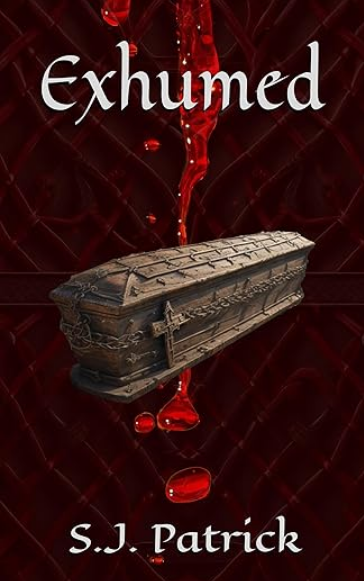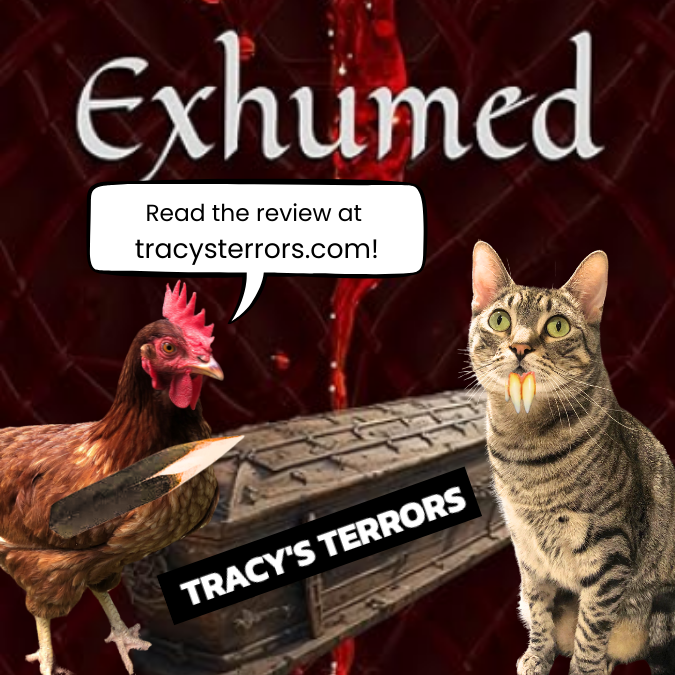

As soon as I saw the title and cover art of S.J. Patrick’s Exhumed (2024), I knew that I had to read it. To me, an ornate toe-pincher wrapped in chains is the visual promise of a great vampire novel. The book isn’t quite that. Its characters are simplistic and the temporal scope of the story is too ambitious to be well done. Still, the premise of an archaeological dig gone wrong has a rich horror history, and Patrick uses it to exciting effect. Also, despite the laboratory setting of the early chapters and the protagonist’s medical credentials, Patrick successfully threads the needle of science and mythology, exposing some aspects of the vampire’s anatomy while leaving the mechanics of his more occult powers in obscurity. If you think that the modern transformation of vampires from enigmatic creatures of the night to mere disease vectors is reductive and boring, then you’ll appreciate his more balanced approach as much as I do.
When an archeological dig in the Carpathian mountains uncovers what seems to be a 13th-century vampire, Dr. David Reynolds, an Australian hematologist or blood doctor, is summoned to Stockholm by the European Centre for Disease Prevention and Control (ECDC). There he joins specialists from a variety of fields, including medicine, history, linguistics, and even occultism, to study the creature and assess the potential impact of its discovery. Before long, the vampire, whose name is Csanad Farkas, escapes the ECDC and, in the process, accidentally infects David with his strange disease. David learns more about his condition and Farkas’ history from a group called the Watchers, descendents of the villagers who originally entombed the vampire and ensured his continued confinement until recently. Through their stories and his own budding extra-sensory perception, David learns that Farkas is seeking vengeance against his vampire son Iuliu, who was the mastermind behind his internment. Once Farkas is done with his son, he plans to destroy the Watchers and his most recent progeny, the blood doctor. Up against two Goliaths, David must find a way to kill both Farkas and Iulio before their ancient feud and unquenchable appetites take a bloody toll on the human population.
Patrick picked the perfect premise for Exhumed. The archeological dig that propels the novel’s early chapters has a powerful horror lineage and enough untapped potential for contemporary applications. Employed by writers and directors for decades, the scenario is quaintly spooky in The Mummy (1932) and terrifying in The Exorcist (1973). More recently, in the short story “On Skua Island” (2001), John Langan proves that, far from an exhausted cliche, archeological digs continue to be an ideal catalyst for horror. Why is this set-up so attractive to me and other genre fans? I think it’s because it’s a great way to build suspense: Unearthing relics is a painstaking process and archaeologists are never quite sure what they’re going to bring up. As long-hidden objects are slowly raised from the depths, we are implicitly invited to explore the darkest corners of our imaginations and to confront our fears. And while excavations speak to our psychology through obvious metaphors of light and dark, conscious and unconscious, they also force us to confront the alienness of ancient cultures and the terrible sublimity of time. Like its predecessors, Patrick’s archaeological dig introduces to the modern world something that has been out of circulation for centuries. And if there’s anything that the horror archive of film and fiction has taught us, it’s that this forced intersection between the past and the present can only go one way–terribly wrong.
Aside from using one of my favorite hooks, Patrick also successfully navigates what I think is one of the biggest problems with modern vampire fiction. So many interpretations of vampirism have reduced it to nothing more than a virus, a biological agent that can be understood and controlled through medical means. On the one hand, I understand that the myth needs to be refurbished if it’s to remain relevant in the contemporary world–a context in which, aside from anti-vaxxers, medicine’s truth claims are generally accepted and disease poses the greatest threat to our wellbeing. But I also think that it strips vampirism of its most compelling elements, those parts of the lore that address our desire for transcendent experiences. Taking the vampire out of conversation with age-old theological questions of death, immortality, and sin, the medical discourse that often prevails in the subgenre threatens to place the monster under the fluorescent lights of a sterile hospital. In Exhumed, Patrick runs the risk of demystifying vampirism by doing just what I’ve described–he delivers Farkas to a glass-walled cell in a literal center for disease control. Nonetheless he skillfully manages to avoid the potential pitfalls of this plot line by following the middle path: While he exposes some of the physical anomalies of the condition–for instance, Farkas’ abnormally large adrenal glands–he leaves the more significant mysteries of immortality and mind control in place. In Patrick’s hands, the vampire’s body may be subject to examination, but his supernatural secrets are impervious to probes and scans. To my surprise–and satisfaction–they remain shrouded.
While Exhumed has its strong points, character development isn’t one of them. David, our protagonist, lacks a personal history and never reflects on the life that he lived before entering the ECDC. It’s as if he had no colleagues, friends or family; no work projects to worry about, trash to take out, or apartment to maintain; in short, none of the baggage that typically comes with adulthood and would almost certainly accompany a career as a world-renown medical specialist. He’s remarkably free of all past associations and fully present in a way that even Eckhart Tolle could never be. While admirable, it’s also an unconvincing representation of a human being. His personality could have been delineated through flashbacks to his home in Sydney; but, instead, the majority of the book’s chapters are wasted on Farkas, who–stolidly maintaining the same schematic outlook until the end–doesn’t reward the reader’s prolonged attention with any kind of personal growth. Driven by only two motivations–anger and hunger–he’s about as well-rounded as a Punch and Judy character. I’m not saying that he needs to be likable, but he needs to be interesting, especially since we’re expected to follow him for hundreds of pages, depicting hundreds of years.
We follow Farkas from 363 AD to 1241; and–counterintuitive though it may be–it’s this astonishing breadth of scope that makes the vampire such a thinly drawn figure. A few strategically placed passages about his origins would have been enough to make the point that he’s old and has enemies. But instead of gesturing toward this background information, Patrick insists that we accompany Farkas from the moment of his creation to the time of his entombment, abiding with him in isolated hideouts as the Roman Empire gives way to the various hordes sweeping across Europe. People are a product of their specific time and place. So by situating Farkas in a broad sketch of history, covering a span of years that would be impossible (as well as undesirable) to depict with any detail, Patrick ends up with a vampire who is as flat and unreal as the events unfolding around him. Instead of a nuanced character with a constellation of traits attributable to a particular period, we get a figure who is reduced to the basic urges that, from a great distance at least, seem to move history forward.
All of this makes me wonder why Patrick assigned himself such a difficult task. Not only is he trying to represent vast swathes of time, but he’s going back to an era that, even with the most active and historically informed imagination, is almost impossible to access from 2024. There’s only one writer I can think of who has written great Roman Empire horror and that’s the inimitable Gemma Files in her amazing short story “Sent Down”–if you haven’t read it, do yourself a favor. Files’ secret is this: Instead of going wide like Patrick, she focuses on a particular set of power dynamics on the margins of the Empire where colonization has collapsed and cultural confusion reigns. It’s in this space of political, linguistic, and religious slippage that she coaxes a familiar humanity–one characterized by loneliness, desperation, and brutality–into being. It’s a magic trick that few can pull off. I could go on and on about Files, but let’s return to Patrick and his vampire. It’s a very brave writer who would try to portray the circumstances and interior life of a Visigoth in the Roman Empire. Farkas is not persuasive in this role, but I applaud Patrick for his attempt.
By the time I reached the end of Exhumed, I knew that I would not pre-order the sequel, which comes out this November. Complete with explosions and automatic gunfire, the novel’s final chapters read like the transcription of a big budget action film, and Patrick–by way of the narrator–openly acknowledges the influence of a visual, blockbusting aesthetic. I prefer something more traditional and low-key. When vampires defend themselves with paramilitary teams and fight with guns instead of teeth, I know that it’s time for me to bow out. Still, I don’t regret having read Exhumed because Patrick’s enthusiasm for vampires is infectious and it has rekindled my own. 2024 has been a busy year in the sub-genre, and I’m excited to see how other authors have interpreted my favorite monster.